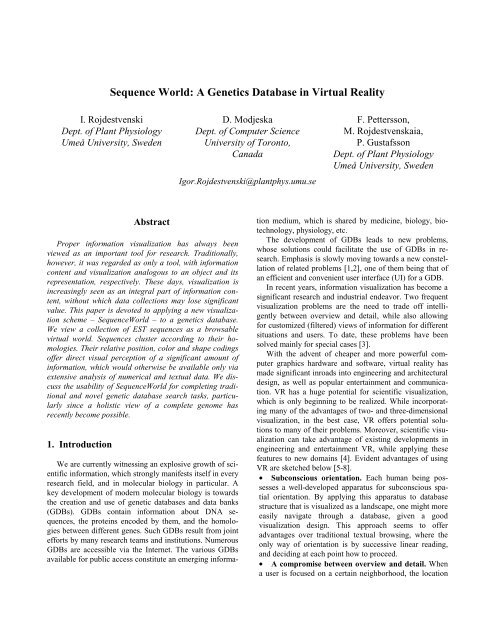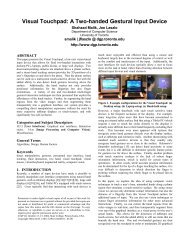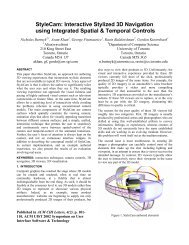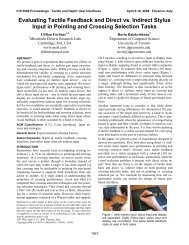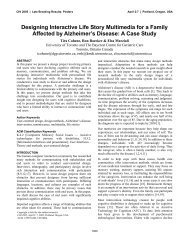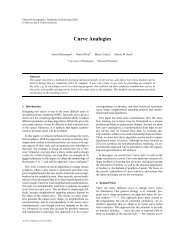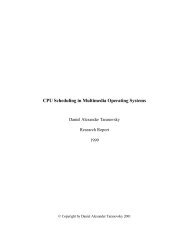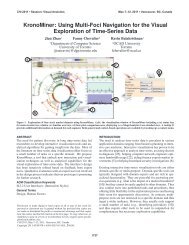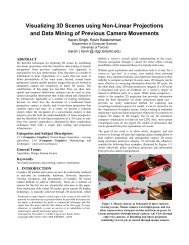A Genetics Database in Virtual Reality - University of Toronto ...
A Genetics Database in Virtual Reality - University of Toronto ...
A Genetics Database in Virtual Reality - University of Toronto ...
You also want an ePaper? Increase the reach of your titles
YUMPU automatically turns print PDFs into web optimized ePapers that Google loves.
Sequence World: A <strong>Genetics</strong> <strong>Database</strong> <strong>in</strong> <strong>Virtual</strong> <strong>Reality</strong><br />
I. Rojdestvenski<br />
Dept. <strong>of</strong> Plant Physiology<br />
Umeå <strong>University</strong>, Sweden<br />
D. Modjeska<br />
Dept. <strong>of</strong> Computer Science<br />
<strong>University</strong> <strong>of</strong> <strong>Toronto</strong>,<br />
Canada<br />
Igor.Rojdestvenski@plantphys.umu.se<br />
F. Pettersson,<br />
M. Rojdestvenskaia,<br />
P. Gustafsson<br />
Dept. <strong>of</strong> Plant Physiology<br />
Umeå <strong>University</strong>, Sweden<br />
Abstract<br />
Proper <strong>in</strong>formation visualization has always been<br />
viewed as an important tool for research. Traditionally,<br />
however, it was regarded as only a tool, with <strong>in</strong>formation<br />
content and visualization analogous to an object and its<br />
representation, respectively. These days, visualization is<br />
<strong>in</strong>creas<strong>in</strong>gly seen as an <strong>in</strong>tegral part <strong>of</strong> <strong>in</strong>formation content,<br />
without which data collections may lose significant<br />
value. This paper is devoted to apply<strong>in</strong>g a new visualization<br />
scheme – SequenceWorld – to a genetics database.<br />
We view a collection <strong>of</strong> EST sequences as a browsable<br />
virtual world. Sequences cluster accord<strong>in</strong>g to their homologies.<br />
Their relative position, color and shape cod<strong>in</strong>gs<br />
<strong>of</strong>fer direct visual perception <strong>of</strong> a significant amount <strong>of</strong><br />
<strong>in</strong>formation, which would otherwise be available only via<br />
extensive analysis <strong>of</strong> numerical and textual data. We discuss<br />
the usability <strong>of</strong> SequenceWorld for complet<strong>in</strong>g traditional<br />
and novel genetic database search tasks, particularly<br />
s<strong>in</strong>ce a holistic view <strong>of</strong> a complete genome has<br />
recently become possible.<br />
1. Introduction<br />
We are currently witness<strong>in</strong>g an explosive growth <strong>of</strong> scientific<br />
<strong>in</strong>formation, which strongly manifests itself <strong>in</strong> every<br />
research field, and <strong>in</strong> molecular biology <strong>in</strong> particular. A<br />
key development <strong>of</strong> modern molecular biology is towards<br />
the creation and use <strong>of</strong> genetic databases and data banks<br />
(GDBs). GDBs conta<strong>in</strong> <strong>in</strong>formation about DNA sequences,<br />
the prote<strong>in</strong>s encoded by them, and the homologies<br />
between different genes. Such GDBs result from jo<strong>in</strong>t<br />
efforts by many research teams and <strong>in</strong>stitutions. Numerous<br />
GDBs are accessible via the Internet. The various GDBs<br />
available for public access constitute an emerg<strong>in</strong>g <strong>in</strong>formation<br />
medium, which is shared by medic<strong>in</strong>e, biology, biotechnology,<br />
physiology, etc.<br />
The development <strong>of</strong> GDBs leads to new problems,<br />
whose solutions could facilitate the use <strong>of</strong> GDBs <strong>in</strong> research.<br />
Emphasis is slowly mov<strong>in</strong>g towards a new constellation<br />
<strong>of</strong> related problems [1,2], one <strong>of</strong> them be<strong>in</strong>g that <strong>of</strong><br />
an efficient and convenient user <strong>in</strong>terface (UI) for a GDB.<br />
In recent years, <strong>in</strong>formation visualization has become a<br />
significant research and <strong>in</strong>dustrial endeavor. Two frequent<br />
visualization problems are the need to trade <strong>of</strong>f <strong>in</strong>telligently<br />
between overview and detail, while also allow<strong>in</strong>g<br />
for customized (filtered) views <strong>of</strong> <strong>in</strong>formation for different<br />
situations and users. To date, these problems have been<br />
solved ma<strong>in</strong>ly for special cases [3].<br />
With the advent <strong>of</strong> cheaper and more powerful computer<br />
graphics hardware and s<strong>of</strong>tware, virtual reality has<br />
made significant <strong>in</strong>roads <strong>in</strong>to eng<strong>in</strong>eer<strong>in</strong>g and architectural<br />
design, as well as popular enterta<strong>in</strong>ment and communication.<br />
VR has a huge potential for scientific visualization,<br />
which is only beg<strong>in</strong>n<strong>in</strong>g to be realized. While <strong>in</strong>corporat<strong>in</strong>g<br />
many <strong>of</strong> the advantages <strong>of</strong> two- and three-dimensional<br />
visualization, <strong>in</strong> the best case, VR <strong>of</strong>fers potential solutions<br />
to many <strong>of</strong> their problems. Moreover, scientific visualization<br />
can take advantage <strong>of</strong> exist<strong>in</strong>g developments <strong>in</strong><br />
eng<strong>in</strong>eer<strong>in</strong>g and enterta<strong>in</strong>ment VR, while apply<strong>in</strong>g these<br />
features to new doma<strong>in</strong>s [4]. Evident advantages <strong>of</strong> us<strong>in</strong>g<br />
VR are sketched below [5-8].<br />
• Subconscious orientation. Each human be<strong>in</strong>g possesses<br />
a well-developed apparatus for subconscious spatial<br />
orientation. By apply<strong>in</strong>g this apparatus to database<br />
structure that is visualized as a landscape, one might more<br />
easily navigate through a database, given a good<br />
visualization design. This approach seems to <strong>of</strong>fer<br />
advantages over traditional textual brows<strong>in</strong>g, where the<br />
only way <strong>of</strong> orientation is by successive l<strong>in</strong>ear read<strong>in</strong>g,<br />
and decid<strong>in</strong>g at each po<strong>in</strong>t how to proceed.<br />
• A compromise between overview and detail. When<br />
a user is focused on a certa<strong>in</strong> neighborhood, the location
is displayed <strong>in</strong> a detailed view. Via peripheral vision,<br />
however, one can perceive other parts <strong>of</strong> the data structure,<br />
presented as geographical areas. This approach enables<br />
the user to recognize both the entire structure and<br />
his/her location <strong>in</strong> it.<br />
• Cross-reference visualization. There is much potential<br />
for visualiz<strong>in</strong>g cross-references relevant to a database<br />
item. Indeed, any object <strong>in</strong> three dimensions has 6 degrees<br />
<strong>of</strong> freedom (3 spatial coord<strong>in</strong>ates and 3 orientation coord<strong>in</strong>ates).<br />
These coord<strong>in</strong>ates, along with the color, shape<br />
and texture used to code objects, may be valuable for<br />
show<strong>in</strong>g homologies and other relationships between database<br />
entries. For example, spatial proximity <strong>in</strong> VR might<br />
represent compartmentalization <strong>of</strong> gene products <strong>in</strong> an<br />
organelle. Here, spatial proximity <strong>in</strong> VR would signify<br />
spatial proximity <strong>in</strong> the real organism.<br />
• Memoriz<strong>in</strong>g search results. Studies [9] have shown<br />
that people with exceptional memory <strong>of</strong>ten learn by l<strong>in</strong>k<strong>in</strong>g<br />
concepts to objects (e.g., trees, fences) <strong>in</strong> a specific<br />
imag<strong>in</strong>ary "landscape". The act <strong>of</strong> remember<strong>in</strong>g seems to<br />
resemble brows<strong>in</strong>g <strong>in</strong> an <strong>in</strong>formation system (here a mental<br />
landscape) composed <strong>of</strong> these objects. A similar process<br />
may be applied to a VR landscape used as a framework<br />
for memory.<br />
• Creation <strong>of</strong> customized virtual worlds, conta<strong>in</strong><strong>in</strong>g<br />
only relevant project data. For example, one might have<br />
the opportunity to save database queries as virtual<br />
neighborhoods. This tool might be convenient for monitor<strong>in</strong>g<br />
a research project: the complete collection <strong>of</strong> queries<br />
could be seen as a unity, and <strong>in</strong>spection <strong>of</strong> a specific<br />
query could occur via a walk <strong>in</strong> virtual space.<br />
The aim <strong>of</strong> this paper is to discuss the visualization <strong>of</strong> a<br />
genetics database as an organized collection <strong>of</strong> objects <strong>in</strong> a<br />
virtual landscape.<br />
2. <strong>Genetics</strong> databases: Why <strong>Virtual</strong> <strong>Reality</strong><br />
Genetic databases <strong>in</strong> general have the follow<strong>in</strong>g characteristics:<br />
• A vast amount <strong>of</strong> data. Genetic databases vary <strong>in</strong><br />
size, but efficient representation <strong>of</strong> a liv<strong>in</strong>g organism’s<br />
genome generally requires thousands <strong>of</strong> data entries. For<br />
example, a complete human genome is estimated to conta<strong>in</strong><br />
about 3 billion base pairs [2].<br />
• Complex data representation patterns. Data is represented<br />
<strong>in</strong> mixed graphical and textual form, each part <strong>of</strong><br />
which is essential for efficient work.<br />
• Many classes <strong>of</strong> data. In addition to gene sequences,<br />
the database conta<strong>in</strong>s descriptions <strong>of</strong> prote<strong>in</strong>s encoded by<br />
genes; gene location and function <strong>in</strong> an organism; and<br />
gene homologies.<br />
• A significant amount <strong>of</strong> cross-referenc<strong>in</strong>g and<br />
hidden similarities. Genes can be l<strong>in</strong>ked <strong>in</strong> several ways,<br />
<strong>in</strong>clud<strong>in</strong>g the follow<strong>in</strong>g:<br />
◊<br />
◊<br />
◊<br />
◊<br />
◊<br />
spatial proximity <strong>of</strong> their products' locations <strong>in</strong><br />
an organism (e.g., genes <strong>of</strong> the thylakoid membrane<br />
prote<strong>in</strong>s <strong>in</strong> plant cells);<br />
functional similarities <strong>of</strong> their products <strong>in</strong> different<br />
parts <strong>of</strong> an organism (e.g., genes <strong>of</strong> different<br />
carboanhydrases <strong>in</strong> plants and animals);<br />
<strong>in</strong>ternal homologies with<strong>in</strong> the gene or prote<strong>in</strong><br />
sequences;<br />
similarities <strong>in</strong> activation/deactivation patterns;<br />
representation <strong>of</strong> parts <strong>of</strong> the same pathway (e.g.,<br />
genes <strong>of</strong> the Calv<strong>in</strong> cycle enzymes);<br />
◊ jo<strong>in</strong>t membership <strong>in</strong> a particular adaptation/acclimation<br />
mechanism (e.g., genes <strong>of</strong> freez<strong>in</strong>g<br />
tolerance prote<strong>in</strong>s and other cold acclimation<br />
enzymes);<br />
Given such a complicated structure for data and crossreferenc<strong>in</strong>g,<br />
adequate data representation is essential for<br />
successful and efficient work. Traditionally, a user works<br />
with database <strong>in</strong>formation by brows<strong>in</strong>g through a system <strong>of</strong><br />
menus: these menus allow a user to form queries and obta<strong>in</strong><br />
results as lists. This representation, however, has certa<strong>in</strong><br />
limitations:<br />
• There is a realistic limit to the amount <strong>of</strong> data that a<br />
researcher can perceive at one time.<br />
• The data is presented <strong>in</strong> the form <strong>of</strong> lists. This representation<br />
is effectively one-dimensional, so that brows<strong>in</strong>g<br />
<strong>in</strong>dividual list elements is the only way to <strong>in</strong>spect the data.<br />
• The cross-l<strong>in</strong>k<strong>in</strong>g and similarities patterns form a<br />
multidimensional topological network, which conflicts<br />
with the usual one-dimensional representation.<br />
The above limitations make the GDB a promis<strong>in</strong>g candidate<br />
for a 3D visualization technique, whose advantages<br />
may help to overcome these limitations.<br />
3. SequenceWorld: A prototype virtual reality<br />
representation <strong>of</strong> a genetics database.<br />
Concept. The SequenceWorld project is aimed at apply<strong>in</strong>g<br />
the power <strong>of</strong> sensori-motor perception and spatial<br />
navigation to work<strong>in</strong>g with a genetics database. The goal<br />
<strong>of</strong> this prototype version is as follows: to develop and test<br />
a new approach to analyz<strong>in</strong>g data <strong>in</strong> a GDB, us<strong>in</strong>g elements<br />
<strong>of</strong> VR technology and philosophy - a virtual<br />
“knowledge” landscape. This landscape could <strong>of</strong>fer new<br />
<strong>in</strong>sights <strong>in</strong>to the structure <strong>of</strong> data relationships, help to<br />
organize <strong>in</strong>dividual research <strong>in</strong>formation, and make navigation<br />
through large databases easy and <strong>in</strong>formative. Two<br />
work<strong>in</strong>g demos <strong>of</strong> SequenceWorld – “Colors and Shapes”
and “Fad<strong>in</strong>g Annotations” can be found on the Web at<br />
http://130.239.110.70. (The prototypes were<br />
implemented <strong>in</strong> <strong>Virtual</strong> <strong>Reality</strong> Model<strong>in</strong>g Language<br />
(VRML), which can be displayed by utilities <strong>in</strong> WWW<br />
browsers.)<br />
Data source. The database entries represent a small<br />
subset <strong>of</strong> Populus DB, that is, 1106 EST-sequences from<br />
the poplar genome. This data was obta<strong>in</strong>ed with<strong>in</strong> the<br />
framework <strong>of</strong> the Populus project [12], which was began <strong>in</strong><br />
1996 <strong>in</strong> the Swedish <strong>University</strong> <strong>of</strong> Agricultural Sciences <strong>in</strong><br />
Umeå (SLU), <strong>in</strong> collaboration with the Department <strong>of</strong><br />
Plant Physiology at Umeå <strong>University</strong>. The sequences are<br />
annotated accord<strong>in</strong>g to best homologous entry from the<br />
SwissProt database, which l<strong>in</strong>ks the poplar sequences with<br />
sequences from other organisms.<br />
Data landscape. The data landscape was designed as a<br />
2D plane <strong>in</strong> 3D space. Of course, topologically speak<strong>in</strong>g,<br />
3D spaces <strong>of</strong>fer more freedom for position<strong>in</strong>g objects than<br />
do 2D planes. However, the human experience <strong>of</strong> liv<strong>in</strong>g<br />
with gravity restricts our built-<strong>in</strong> navigation abilities to a<br />
more or less two-dimensional layer on the ground. For this<br />
reason, though a SequenceWorld user has full mobility <strong>in</strong><br />
the upper 3D half-space, data objects' positions are restricted<br />
to a 2D square, which represents "the ground."<br />
Data position<strong>in</strong>g. We clusterized database entries accord<strong>in</strong>g<br />
to similarity (as def<strong>in</strong>ed by the BLAST algorithm<br />
[12]), us<strong>in</strong>g a Monte-Carlo simulated anneal<strong>in</strong>g algorithm<br />
<strong>in</strong> 2D space [13]. With<strong>in</strong> the framework <strong>of</strong> this algorithm,<br />
we treated database objects as particles <strong>in</strong> 2D space, with a<br />
pair <strong>in</strong>teraction function depend<strong>in</strong>g, for each pair <strong>of</strong> particles,<br />
on mutual homology. When the “temperature” <strong>of</strong><br />
such a system is decreased, the particles “condense” <strong>in</strong>to<br />
clusters. Each cluster is formed by the particles (data entries,<br />
sequences) with the highest mutual homology.<br />
Colors and Shapes. In the “Colors and Shapes” version<br />
<strong>of</strong> SequenceWorld, we selected appropriate shape and<br />
color cod<strong>in</strong>g for objects represent<strong>in</strong>g database entries. To<br />
keep the representation consistent, the design was based on<br />
annotation, with shape and color be<strong>in</strong>g reserved for the<br />
function <strong>of</strong> the correspond<strong>in</strong>g (best homologous) SwissProt<br />
[13] entry and its organismal orig<strong>in</strong>, respectively.<br />
Such design decisions, as well as concrete implementation,<br />
are not unique to this project: for another database (or research<br />
task with the same database), similar choices could<br />
be made accord<strong>in</strong>g to <strong>in</strong>dividual requirements. A screen<br />
shot <strong>of</strong> “Colors and Shapes” is shown <strong>in</strong> Figure 1.<br />
Navigation and search. A user navigates <strong>in</strong> SequenceWorld<br />
via a VRML viewer toolbar. The user can<br />
ascend and descend, thus vary<strong>in</strong>g the level <strong>of</strong> detail <strong>in</strong> the<br />
field <strong>of</strong> view; the user can also turn right and left, and go<br />
backward and forward, to <strong>in</strong>spect regions <strong>of</strong> <strong>in</strong>terest. A<br />
Fig. 1. A screen shot <strong>of</strong> “Colors and Shapes”<br />
viewer tool allows a user to jump directly to a predef<strong>in</strong>ed<br />
viewpo<strong>in</strong>t, by choos<strong>in</strong>g the target viewpo<strong>in</strong>t from a dropdown<br />
menu. This feature was used <strong>in</strong> a simple search eng<strong>in</strong>e<br />
for SequenceWorld. Search requests can be submitted<br />
either by sequence name or by keyword. A search by sequence<br />
name creates a viewpo<strong>in</strong>t (listed on a pull-down<br />
menu) for a searched sequence, which the user can access<br />
via SequenceWorld controls. A keyword search presents<br />
the database entries, annotations <strong>of</strong> which conta<strong>in</strong> a given<br />
word or a phrase, marked by white r<strong>in</strong>gs on appropriate<br />
virtual objects. A keyword search also creates up to 50<br />
viewpo<strong>in</strong>ts for sequences match<strong>in</strong>g the search criterion.<br />
Us<strong>in</strong>g transparency and the third dimension. In a<br />
close-up view, a homologies stem appears above each<br />
shape with<strong>in</strong> a certa<strong>in</strong> spatial range. The homologies stem<br />
represents a set <strong>of</strong> up to 10 closest homologies from SwissProt<br />
DB. Each homology is represented by a section <strong>of</strong><br />
the stem. The longer and more opaque is the section, the<br />
higher is the homology, calculated as a ratio <strong>of</strong> the SwissProt<br />
DB BLAST score and the sequence represented by<br />
the object under the stem, divided by the sequence's selfscore.<br />
The sections are arranged by descend<strong>in</strong>g homology,<br />
i.e., the lowest homology is shown <strong>in</strong> the lowest section <strong>of</strong><br />
the stem. Click<strong>in</strong>g on a section will <strong>in</strong>voke a hyperl<strong>in</strong>k to<br />
SwissProt DB with a description <strong>of</strong> this homology.<br />
More transparency – Fad<strong>in</strong>g Annotations. Another<br />
version <strong>of</strong> SequenceWorld is called “Fad<strong>in</strong>g Annotations “<br />
(See Figure 2). It is based on the "Colors and Shapes" approach<br />
and data structures, and it represents a visual automatic<br />
annotation system. The ma<strong>in</strong> idea is to use transparency<br />
cod<strong>in</strong>g to assess the measure <strong>of</strong> confidence <strong>in</strong><br />
automatically obta<strong>in</strong>ed annotations. The annotations are<br />
taken from the best homologue <strong>in</strong> the SwissProt database.
For each EST sequence, j, credibility factor, σ j is calculated<br />
as<br />
σ<br />
j<br />
=<br />
BLAST<br />
BLAST _ SCORE<br />
_ SCORE( j,<br />
λ)<br />
( j,<br />
j) BLAST _ SCORE( λ,<br />
λ)<br />
where λ is the best homologue from SwissProt. The values<br />
<strong>of</strong> σ j are between 0 and 1: 0 represents a situation <strong>in</strong><br />
which no automatic annotation is available; 1 represents a<br />
100% co<strong>in</strong>cidence <strong>in</strong> sequences, and hence <strong>in</strong> annotations.<br />
Each database object <strong>in</strong> the landscape is now represented<br />
by a comb<strong>in</strong>ation <strong>of</strong> two shapes: a white ball and a colored<br />
cube. The cube's transparency corresponds to the value <strong>of</strong><br />
σ j for the sequence it represents. Thus, for σ j close to 0<br />
(poor annotation credibility), the object is shown as a<br />
white sphere. If annotation credibility is relatively high, a<br />
colored cube beg<strong>in</strong>s to appear, becom<strong>in</strong>g more opaque as<br />
confidence grows. This visual assessment <strong>of</strong> annotation<br />
credibility is surpris<strong>in</strong>gly sensitive, and one can test it by<br />
click<strong>in</strong>g on a shape to see the credibility factor.<br />
Fig. 2. A screen shot <strong>of</strong> “Fad<strong>in</strong>g Annotations”<br />
4. Conclusions<br />
It is difficult to appreciate the features <strong>of</strong> Sequence-<br />
World without navigat<strong>in</strong>g <strong>in</strong> the prototype. At first glance,<br />
the concept seems rather unusual. However, when one becomes<br />
accustomed to the navigation controls, and learns<br />
color and shape cod<strong>in</strong>gs, the <strong>in</strong>formational journey becomes<br />
quite <strong>in</strong>terest<strong>in</strong>g. We shall attempt to summarize the<br />
advantages <strong>of</strong> this novel genetic data representation:<br />
Richness <strong>of</strong> <strong>in</strong>formation. SequenceWorld is very rich<br />
<strong>in</strong> <strong>in</strong>formation, as is immediately apparent, relative to a<br />
traditional "read and reason" paradigm. For example, upon<br />
see<strong>in</strong>g a red cube <strong>in</strong> the prototype demonstration, one easily<br />
associates it with a certa<strong>in</strong> enzyme from Arabidopsis<br />
thaliana - merely because <strong>of</strong> geometrical form. Tall stems<br />
represent well-def<strong>in</strong>ed sequences, while sequences with<br />
short stems h<strong>in</strong>t at further work needed for proper annotation.<br />
Furthermore, SequenceWorld gives one an opportunity<br />
to perceive the GDB as a whole, and when navigat<strong>in</strong>g<br />
it, to ma<strong>in</strong>ta<strong>in</strong> a view at an appropriate level <strong>of</strong> detail.<br />
New knowledge. Paradoxically, SequenceWorld creates<br />
new knowledge. The cluster structure would require<br />
significant effort to perceive by normal brows<strong>in</strong>g methods.<br />
In pr<strong>in</strong>ciple, one could diligently study mutual BLAST<br />
scores <strong>of</strong> different sequences, and reach a conclusion that a<br />
particular set <strong>of</strong> sequences belongs to the same "family."<br />
However, for N sequences, it would take approximately<br />
N 2 /2 operations to identify such cluster<strong>in</strong>g. In Sequence-<br />
World, one glance at the landscape conveys a sense <strong>of</strong> this<br />
structure <strong>in</strong> an efficient, visual style.<br />
Objectivity. SequenceWorld is objective. Once color<br />
and shape cod<strong>in</strong>gs are determ<strong>in</strong>ed, and a procedure is chosen<br />
for def<strong>in</strong><strong>in</strong>g the "semantic proximity" <strong>of</strong> entries (i.e.,<br />
an algorithm for assign<strong>in</strong>g a real number to each sequences<br />
pair), further spatial order<strong>in</strong>g is done algorithmically; the<br />
researcher need only wait to view the result. The exact<br />
position<strong>in</strong>g <strong>of</strong> each object is not preserved <strong>in</strong> a Monte-<br />
Carlo-based procedure; the overall features <strong>of</strong> clusterization,<br />
however are as well def<strong>in</strong>ed as <strong>in</strong> computational statistical<br />
physics, which models critical phenomena such as<br />
liquid condensation or magnetic phase transitions.<br />
Flexibility <strong>in</strong> cluster<strong>in</strong>g algorithms. We based our<br />
proximity algorithm on the traditional BLAST search program.<br />
However, with the advent <strong>of</strong> new and more powerful<br />
homology-seek<strong>in</strong>g techniques, simple BLAST search<br />
could easily be replaced by a more up-to-date technique,<br />
without requir<strong>in</strong>g dramatic changes to our general approach.<br />
By employ<strong>in</strong>g several def<strong>in</strong>itions <strong>of</strong> the “semantic<br />
proximity” <strong>of</strong> database entries, one would have the opportunity<br />
to <strong>in</strong>spect different versions <strong>of</strong> SequenceWorld,<br />
each hav<strong>in</strong>g its own clusterization pattern.<br />
Aesthetics and serendipity. SequenceWorld, while a<br />
fully functional database, also has an aesthetic quality,<br />
which could enrich analysis work relative to traditional<br />
methods. The new technique provides a holistic view,<br />
which at the same time <strong>of</strong>fers the detailed views as needed.<br />
At this stage, it is difficult to predict the research utility <strong>of</strong><br />
SequenceWorld and similar concepts. Nevertheless, they<br />
may prove effective for answer<strong>in</strong>g traditional questions<br />
posed to GDBs, such as ascrib<strong>in</strong>g annotations; the techniques<br />
may also prove effective for new, serendipitous<br />
tasks aris<strong>in</strong>g with the advent <strong>of</strong> systemic studies <strong>of</strong> full<br />
organismal genomes.
In conclusion, SequenceWorld <strong>of</strong>fers a new and promis<strong>in</strong>g<br />
way to look at a genetics database. The new technique<br />
provides a holistic view, which at the same time allows<br />
opportunities to <strong>in</strong>spect detail as necessary. Sequence-<br />
World may be used for perform<strong>in</strong>g traditional tasks; but it<br />
is hoped that the visual representation <strong>of</strong> genetics data may<br />
lead to new tasks and new ways <strong>of</strong> work<strong>in</strong>g, which grow<br />
out <strong>of</strong> acquir<strong>in</strong>g knowledge via direct visual perception.<br />
5. References<br />
[1] S. F. Altschul, M. S. Boguski, W. Gish, J.C. Wootton, "Issues<br />
<strong>in</strong> search<strong>in</strong>g molecular sequence databases", Nat Genet<br />
6, p. 119 (1994)<br />
[2] M. S. Boguski, "The Turn<strong>in</strong>g Po<strong>in</strong>t <strong>in</strong> Genome Research",<br />
Trends <strong>in</strong> Biochemical Sciences 20, p.295 (1995)<br />
[3] D. Modjeska, Technical Report <strong>of</strong> the Computer Science<br />
Research Institute <strong>of</strong> the <strong>University</strong> <strong>of</strong> <strong>Toronto</strong>, <strong>Toronto</strong>:<br />
<strong>University</strong> <strong>of</strong> <strong>Toronto</strong> (1997)<br />
[4] C. Chen, Information Visualisation and <strong>Virtual</strong> Environments,<br />
Spr<strong>in</strong>ger, London (1999)<br />
[5] J. Waterworth, <strong>in</strong> 3D on the Internet: Information, Images<br />
and Interaction (eds Earnshaw, R. & V<strong>in</strong>ce, J.) p. 97, Academic<br />
Press, New York (1996)<br />
[6] J. Waterworth, "Creativity and Sensation: The case for 'Synaesthetic<br />
Media", Leonardo 30, p.327 (1997)<br />
[7] J. Waterworth, “A Pattern <strong>of</strong> Islands: Explor<strong>in</strong>g Public Information<br />
Space <strong>in</strong> a Private Vehicle”<strong>in</strong> Multimedia, Hypermedia<br />
and <strong>Virtual</strong> <strong>Reality</strong> (eds Brusilovsky, P, Kommers,<br />
P and Streitz, N), Spr<strong>in</strong>ger Verlag Lecture Notes <strong>in</strong><br />
Computer Science (1996)<br />
[8] D. Modjeska, "Parallel Worlds: Spatial and Textual Representations<br />
<strong>of</strong> Information Structure", <strong>in</strong> Workshop on Personalised<br />
and Social Navigation <strong>in</strong> Information Space,<br />
Swedish Institute <strong>of</strong> Computer Science, Stockholm (1998)<br />
[9] F.A. Yates, The Art <strong>of</strong> Memory, Routledge and Kegan Paul,<br />
London (1984)<br />
[10] F. Sterky et al, ”Gene discovery <strong>in</strong> the wood-form<strong>in</strong>g tissue<br />
<strong>of</strong> poplar: Analysis <strong>of</strong> 5,692 expressed sequence tags”,<br />
Proc. Natl. Acad. Sci. USA 95, pp.13330-13335 (1998)<br />
[11] E. Aarts, J. Korst, Simulated Anneal<strong>in</strong>g and Boltzmann<br />
Mach<strong>in</strong>es, eds Graham, R.L., Lenstra, J.K. and Tarjan R.E.,<br />
John Wiley & Sons (1990)<br />
[12] S.F. Altschul, W. Gish, W. Miller, E. W. Myers, D.J. Lipman,<br />
"Basic local alignment search tool", J Mol Biol 215,<br />
p. 403 (1990)<br />
[13] SwissProt <strong>Database</strong> WWW Gateway, http://www.expasy.ch


